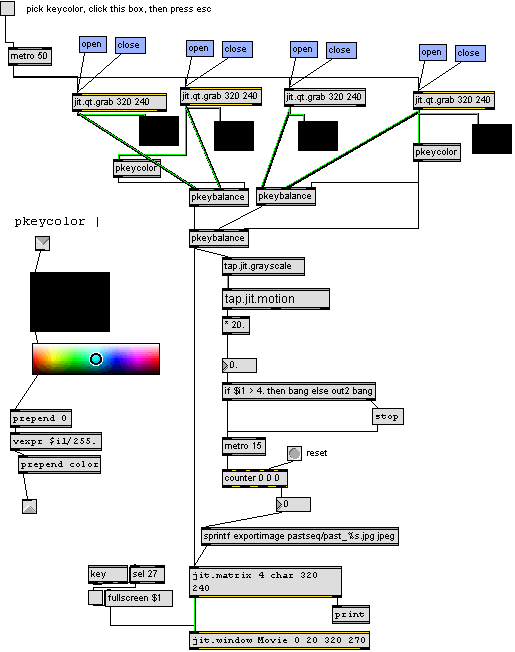Installation
Prototype: OmniVision was exhibited at Gallery II at the
School of Art and Design, San Jose State University, San Jose CA. It
ran from November 1 to Nov 5, 2004.
"It looks very medieval." -Joel Slayton
The headset was suspended from a chain attached to a wire cable
track that traversed the width of the gallery space. Participants
could move back and forth along the length of the cable. However,
participants were prevented from moving perpendicular to the cable,
across the length of the gallery. This was implemented due to
concerns of interference with the other exhibitions. Two monitors
were displayed side by side. The left monitor displayed the current
users view. The right monitor displayed the video documentation of
the Prototype Test Experiments.
The Omni software ran on a 3ghz PC located under the table. The
feeds from the four Logitec Quickcam Pro 400 cameras ran into the PC
which processed the information and sent a video feed back out to
the Virtual IO headset display. The experiment videos ran off of a
MacG4 also located under the table.
Technical
The Prototype: OmniVision software was written in Max/MSP
with Jitter and Tap Tools. The main file, omni is responsible for
taking in the streaming video from the camera feeds and sending them
to the sub-processes. It then displays the resulting video stream
and records image sequence documentation based on motion.
The pkeycolor sub-posses file simply sets up an easy way to select
the (background) color that is removed and replaced with
transparency on the fly.
The pkeybalance file does all the comparison computations. It takes
in two video sources and a key color (the background color replaced
with transparency). A motion index is a floating point number
between 0 and 1 generated by comparing the current frame of a video
feed to the previous frames and taking an average. (0 meaning no
change) The motion indexes of the two feeds are compared. One feed
is keyed into the background of the other based on the motion index.
The higher the index the more is bleeds into the foreground. When
the motion on a feed is so great that the motion index reaches 1 and
the background totally usurps the foreground then pkeybalance
switches the ordering of the layers. The previous background feed is
now the foreground and vice versa.
Omni calls pkeybalace three times, two feed pairs are compared and
layered and the resulting two feeds are then compared and layered in
the same way. In this way the amount that the feeds cover one
another as well as the order in which the feeds are layered is in
constant flux. Thus the directional views are combined and displayed
such that the user witnesses a collage of his or her surroundings.
The current directional video feed with the most motion always being
the topmost layer.
Max/MSP is a visual object oriented programming application written
by Miller Puckette. Currently Miller is developing a related
freeware called PD. Max/MSP is primarily designed for audio
processing. Jitter is an added module for video. Tap Tools is an
added library with a method for video motion index calculation.


